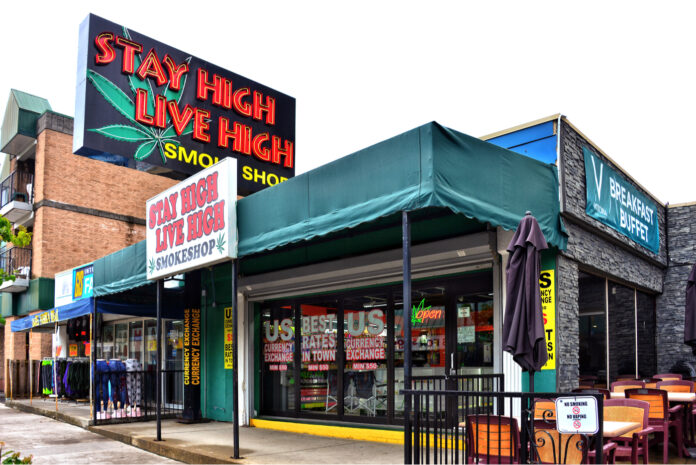As more states legalize recreational and medicinal marijuana and legislators eye legalization on a federal level, cannabis entrepreneurs are poised to see a sharp increase in opportunities to grow their businesses. As it stands, legal cannabis sales grew 46 percent in the United States last year with sales surpassing $17.5 billion, according to the Colorado-based cannabis research firm BDSA. That’s up from $12.1 billion in 2019. And by 2026, BSDA forecasts U.S. sales to reach up to $41.3 billion. So, with the cannabis space opening up around the country, what’s one of the best ways for businesses to reach new customers? Out-of-home (OOH) advertising.
Out-of-home advertising is simply advertising viewed outside the home. If you have yet to explore the power of OOH, it’s time. Here’s what cannabis advertisers need to know about leveraging the method.
OOH reaches people where they are
Billboards likely are the first thing that comes to mind when someone mentions OOH. While they are among the most common formats, the medium goes far beyond traditional roadside billboards and gives advertisers the ability to surround and immerse consumers. Today’s OOH inventory is expansive and includes:
- Static billboards. These are one-message signs commonly seen dotting heavy-traffic areas such as highways, primary arterials, and major intersections.
- Digital billboards. Located in the same places as their static counterparts, digital billboards allow advertisers to quickly launch agile campaigns on eye-catching screens, rotate ads, and switch out artwork in seconds with a few clicks of a button.
- Wallscapes and murals. Wallscapes and murals are printed or painted on highly visible real estate and rival the impact of large billboard ads. These ads have a shareable quality and large social media appeal.
- Street furniture: Think of street furniture as ads at eye level. Advertisements attached to transit shelters, newsstands and kiosks, bike and scooter shares, urban panels, phone kiosks, city information pillars, street poles, and some in-store structures all are forms of street-furniture advertising.
- Transit media. These ads live on taxi and rideshare tops; wrapped around buses, trains, trolleys, and subway cars; and in airports and transit centers where commuter traffic is high. Airborne banners and mobile billboards fall into this category, too.
- Place-based media. These ads are placed everywhere customers are –– in elevators, bars and restaurants, cinemas and theatres, arenas, stadiums, and malls.
Consumers have eyes on OOH
Now that prolonged lockdowns are a thing of the past, consumers are paying greater attention to their surroundings. In fact, a recent Harris poll reported a 45-percent increase in people noticing billboards, outdoor video screens, posters, signage, and other OOH media since pandemic shutdowns ended.
That’s great news for cannabis advertisers looking to connect with consumers and make their mark, especially in an industry limited as to where and how it can advertise. Traditional mediums are out for cannabis companies. No television or radio advertising. Social media also is off limits. However, the regulations cannabis businesses must abide by shouldn’t be viewed as a negative, especially when one of the most cost-effective mediums with the highest return on investment remains fair game, barring some local regulations. Even Jay–Z’s cannabis brand Monogram has taken advantage of OOH in recent months.
In two different OOH campaigns, Monogram created provocative ads calling out the divide in legalization across states and the hypocrisy of America’s drug policies. One ad read, “If you use a flamethrower to light a joint, you’ll be arrested in 17 states. But not for the flamethrower.”
What OOH can do for cannabis businesses
For each dollar spent on OOH advertising, an average of $5.97 is generated in product sales, according to a recent report from the Outdoor Advertising Association of America. Another study by Nielsen gives insight into who is seeing and interacting with OOH. People aged 16-34 are the most engaged, with some 66 percent of smartphone users reporting taking action after viewing an outdoor ad. Some 20 percent even reported visiting a business with a directional OOH advertisement.
Capitalizing on the benefits of OOH is possible with end-to-end online buying platforms.
OOH platforms enable advertisers to discover the best locations and markets, negotiate pricing, purchase, and evaluate a campaign’s effectiveness. Some even provide data and track conversions in real-time, attributing online sales to a campaign and measuring incremental sales with lift studies.
The best OOH buying platforms offer integrated cannabis filters that pinpoint OOH units that are compliant with local and state advertising laws. California cannabis businesses can filter out billboards located on interstates and state highways that cross the state’s border, where cannabis ads are barred. Those in Colorado, where there’s a cannabis advertising buffer zone around schools and parks, can ensure they’re compliant with local regulations before spending time, money, and resources on an OOH ad buy.
With compliant OOH advertising buys, your cannabis business can reap serious benefits. OOH can help introduce your brand to new markets and also give your business a clear way to establish its brand and share calls to action with consumers, leading customers to a physical storefront or activating e-commerce sales by driving website traffic.
OOH shouldn’t be overlooked by cannabis businesses looking to capitalize on massive market growth. Yes, the advertising landscape is limited and complicated for cannabis sellers, but with the right partner and online platform, you can plan, stay compliant with local laws, and execute ads to grow your market share.












